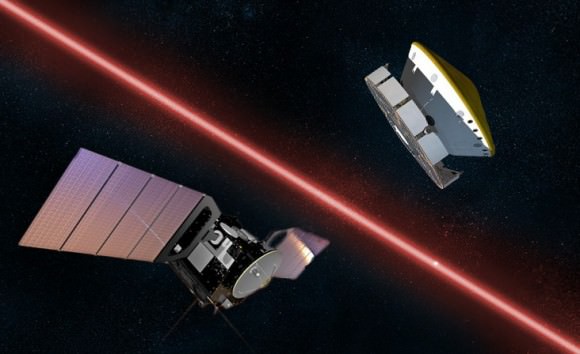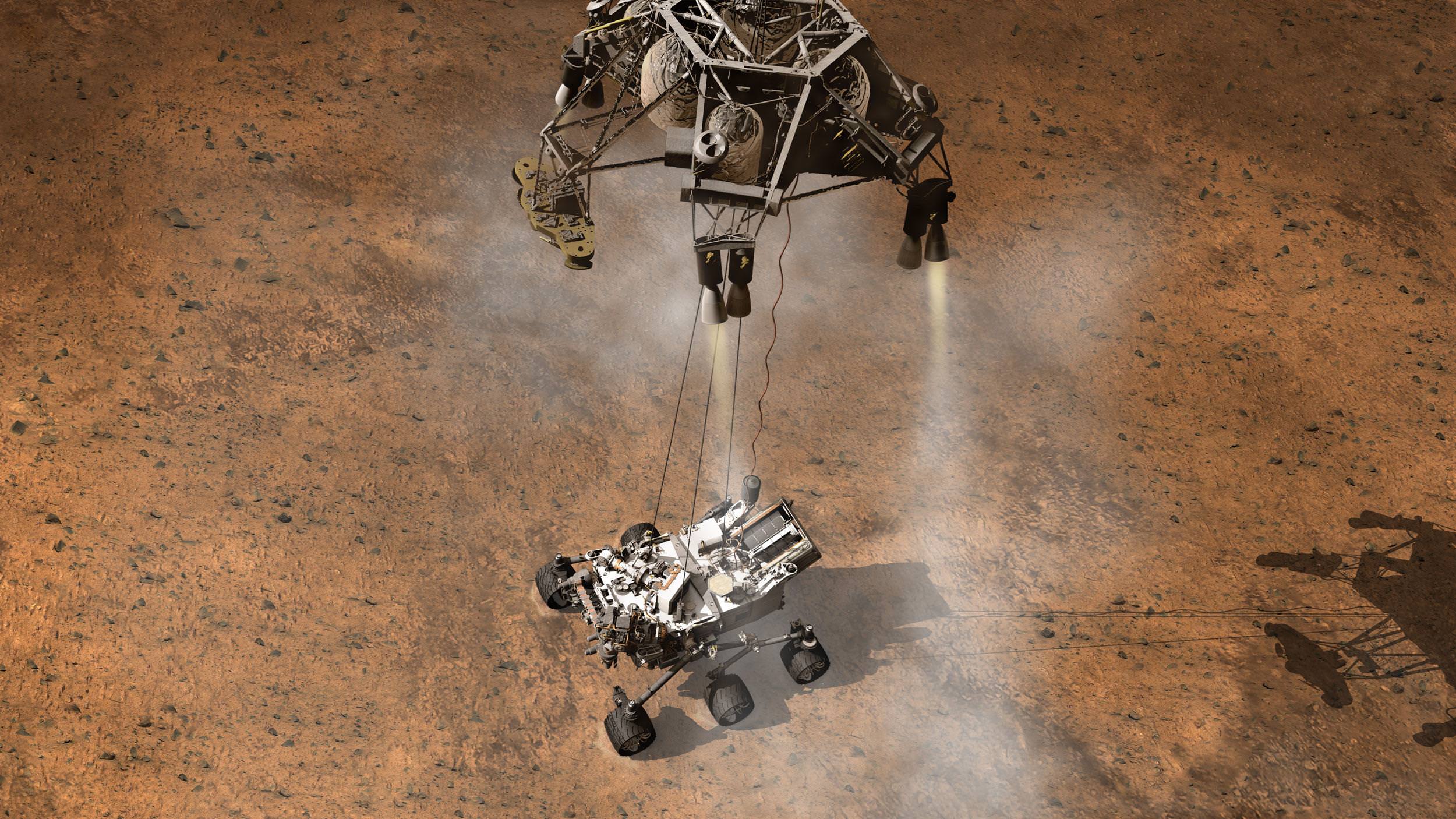Image Caption: NASA’s Mars Odyssey will relay near real time signals of this artist’s concept depicting the moment that NASA’s Curiosity rover touches down onto the Martian surface. NASA’s Mars Reconnaissance Orbiter (MRO) and ESA’s Mars Express (MEX) orbiter will also record signals from Curiosity for later playback, not in real time. Credit: NASA
It’s now just T minus 9 Days to the most difficult and complex Planetary science mission NASA has ever attempted ! The potential payoff is huge – Curiosity will search for signs of Martian life
The key NASA orbiter at Mars required to transmit radio signals of a near real-time confirmation of the August 5/6 Sunday night landing of NASA’s car sized Curiosity Mars Science Lab (MSL) rover is now successfully in place, and just in the nick of time, following a successful thruster firing on July 24.
Odyssey will transmit the key signals from Curiosity as she plunges into the Martian atmosphere at over 13,000 MPH (21,000 KPH) to begin the harrowing “7 Minutes of Terror” known as “Entry, Descent and Landing” or EDL – all of which is preprogrammed !
Engines aboard NASA’s long lived Mars Odyssey spacecraft fired for about 6 seconds to adjust the orbiters location about 6 minutes ahead in its orbit. This will allow Odyssey to provide a prompt confirmation of Curiosity’s landing inside Gale crater at about 1:31 a.m. EDT (531 GMT) early on Aug. 6 (10:31 p.m. PDT on Aug. 5) – as NASA had originally planned.
Without the orbital nudge, Odyssey would have arrived over the landing site about 2 minutes after Curiosity landed and the signals from Curiosity would have been delayed.
A monkey wrench was recently thrown into NASA relay signal plans when Odyssey unexpectedly went into safe mode on July 11 and engineers weren’t certain how long recovery operations would take.
“Information we are receiving indicates the maneuver has completed as planned,” said Mars Odyssey Project Manager Gaylon McSmith of NASA’s Jet Propulsion Laboratory, Pasadena, Calif. “Odyssey has been working at Mars longer than any other spacecraft, so it is appropriate that it has a special role in supporting the newest arrival.”
Odyssey has been in orbit at Mars since 2001 conducting orbital science investigations.
Read my review article on Odyssey’s science discoveries – here
Odyssey serves as the primary communications relay for NASA’s other recent surface explorers – Opportunity, Spirit and Phoenix. Opportunity recently passed 3000 Sols of continuous operations.
Two other Mars orbiters, NASA’s Mars Reconnaissance Orbiter and the European Space Agency’s Mars Express, also will be in position to receive radio transmissions from the Mars Science Laboratory during its descent. However, they will be recording information for later playback, not relaying it immediately, as only Odyssey can.
“We began optimising our orbit several months ago, so that Mars Express will have an orbit that is properly “phased” and provides good visibility of MSL’s planned trajectory,” says Michel Denis, Mars Express Spacecraft Operations Manager.
Mars Express has been orbiting the planet since December 2003.

Image Caption: Mars Express supports Curiosity MSL. Credit: ESA
“NASA supported the arrival of Mars Express at Mars in 2003, and, in the past few years, we have relayed data from the rovers Spirit and Opportunity,” says ESA’s Manfred Warhaut, Head of Mission Operations.
“Mars Express also tracked the descent of NASA’s Phoenix lander in 2008 and we routinely share our deep space networks.
“Technical and scientific cooperation at Mars between ESA and NASA is a long-standing and mutually beneficial activity that helps us both to reduce risk and increase the return of scientific results.”
Watch NASA TV online for live coverage of Curiosity landing: mars.jpl.nasa.gov or www.nasa.gov



My father and I are space buffs of the highest order. My own interest is thanks to him.
I’m going to Michigan to spend some time with my Dad the day after Curiosity gets to Mars. (It’ll be my first visit without wife or kids since 1996) We’ve already said we’ll either raise a glass to the new rover or the to the twisted wreck. (We’re both sorta cautious about this landing, and we’re still grumpy about Mars Polar Lander in 1999.)
It’s very convenient that the landing time in Western Australia will be Monday 6 August at 1:31pm, lunch time! I intend to watch it streaming live, over a beautiful seafood lunch on the beachfront here in Perth! Yum. And going on recent weather, it may well be a beautiful blue-sky winter day.
But I have not yet seen mention of a streaming site. Is it the NASA site? Anyone tell me for sure? PJC
Yes, both public and media channels on NASA TV will provide coverage of the event:
http://www.ustream.tv/nasajpl
Cheers! How’s the winter so far? The best option is NASA HD: http://www.ustream.tv/channel-popup/nasa-hd-tv
Why There is a twisted wire rope seen attached to curiosity while being dropped ? Can you kindly explain. Does’nt put the rover at off balance ?
The wire rope i am told is a sort of electrical umbilical cord relaying data back and forth whilst curiosity is being lowered.The balance of the rover is down to the three nylon ropes that hold the weight. the umbilical cord doesn’t effect the balance thats why it appears twisted and slackened
Keep your fingers crossed. This involves a lot of critical systems that must function almost perfectly.
LC
Yes indeed. I can only admire the faith in technology they have, but I also agree, engineering technology has advanced to such a degree that I feel fairly confident too. Obviously, they wouldn’t attempt it if they didn’t think it had a very, very strong chance of success.
My field was/is electronics and I marvel at the Mercury/Apollo spacecraft. Electronics was NOT reliable in the 1960s and early 1970s. Those early astronauts were very courageous to rely on the primitive electronics then.
But of course, NASA’s work boosted the whole concept of electronics reliability.
Of course the entire space program depended on solid state electronics. If we had for some reason remained with vacuum tubes satellites would have remained very limited and manned spacecraft rather primitive. The Soviets used vacuum tubes for some time and developed the art of making vacuum tubes that were miniaturized to the size of a cough drop. They used these in both their space program and military. Back in the mid 1970s a Soviet pilot flew a then late model MIG into Japan and to the astonishment of the western analysts who looked at the aircraft found it largely used lots of these mini-vacuum tubes.
The Apollo spacecraft in some ways amazes me. This was by any comparison with modern technology almost clunky, like comparing a fuel-electric hybrid with a Ford model A. The onboard computers in the command and lunar modules were rump versions of something like the Commodor 64. The whole program was built very large and they managed to make it work for the most part.
LC
Actually, it was only the ignorant press who were astonished about that and (as I’m old enough to recall) they even made fun of it; however, to the analysts, there was a logical reason to the use of mini-vacuum tubes in the Mikoyan-Gurevich MiG-25:
* The vacuum tubes were more tolerant of temperature extremes, thereby removing the need for providing complex environmental controls inside the avionics bays;
* The vacuum tubes were easy to replace in remote northern airfields where sophisticated transistor parts might not have been readily available;
* The vacuum tubes gave the MiG-25P’s original Smerch-A radar enormous power – about 600 kilowatts;
* The use of vacuum tubes also made the aircraft’s systems more resistant to electromagnetic pulse (EMP) in a nuclear war.
It is sort of the same reason I guess that electric guitar amps have vacuum tubes. However, it is the case that the USSR was behind the power curve on electronics. One reason the USSR ended was that in the late 70s SONY color TVs and Apple computers started to make their way into the country. The Russian made color TV had a tendency to catch on fire, and their best computers were vault sized things. More of the average Russians realized that they were had.
LC
You may find these two links interesting:
History of computer hardware in Soviet Bloc countries;
East German, Polish and Soviet CPUs and Support Chips.
wow! i can only imagine the tremendous amount of math that went into this entire operation. I am biggity psyched for this landing!
Shame they couldn’t finagle it to land in prime time dangit,
I can’t stay up to 2 AM on Monday morning to watch this. But I have to watch it now and call in sick
on Monday! Bad NASA!